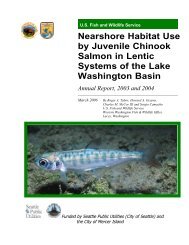2006 Water Comprehensive Plan - City of Bellevue
2006 Water Comprehensive Plan - City of Bellevue
2006 Water Comprehensive Plan - City of Bellevue
- No tags were found...
You also want an ePaper? Increase the reach of your titles
YUMPU automatically turns print PDFs into web optimized ePapers that Google loves.
• Apparent Losses: Includes unauthorized uses and customer meter inaccuracies,both <strong>of</strong> which are lost revenue opportunities.• Real Losses: Includes various types <strong>of</strong> system leaks. A certain level <strong>of</strong> leaks isunavoidable, however, leaks beyond that level should be fixed in order to not undulyburden both the natural resource and the physical infrastructure.• Remainder: This is not part <strong>of</strong> the IWA’s <strong>of</strong>ficial water balance format. Under theIWA’s protocol, any amount that can not be assigned to another category is put intothe leaks category. For this <strong>Water</strong> <strong>Comprehensive</strong> <strong>Plan</strong>, any amount that could notbe assigned to another category was put into the Remainder category, toacknowledge that data systems are not currently set up to track all <strong>of</strong> thesubcategories discussed above.The third level simply further splits water into additional sub-categories.<strong>Water</strong> Loss AnalysisIn 2003, <strong>Bellevue</strong> developed a “<strong>Water</strong> System Loss Report”, which summarized analysis <strong>of</strong>unaccounted for water conducted between 2001-2003 to better understand and quantify itsvarious components. The report included analysis <strong>of</strong> five areas:• Distribution system losses• Inlet meter discrepancies• Customer meter inaccuracies• Billing adjustments• Miscellaneous other uses (e.g. maintenance, construction, fire-fighting)<strong>Bellevue</strong>’s analysis concluded that between 1998 and 2000, its non revenue water duringthat period was comprised as follows:10% System leaks35% Inlet meter inaccuracies45% Customer meter inaccuracies10% Miscellaneous other100% Total non revenue waterLeak Detection Survey: In 2001, <strong>Bellevue</strong> retained Utility Services Associates to conductwater line leak detections surveys on a representative portion <strong>of</strong> the distribution system.Again, the water lost to leaks was estimated at approximately 1.0%, or 60 million gallons peryear. The survey covered approximately 45 miles (or 8%) <strong>of</strong> the distribution systemrepresenting various material types, geographic locations, soil conditions, and pipecharacteristics such as size and age. Leakage was generally caused by minor system leaksfrom pipes and appurtenances, including hydrant foot valves. The report recommendedperiodic leak detection surveys on representative samples <strong>of</strong> the water system, as a costeffectivetool to avoid escalation <strong>of</strong> water loss due to system leaks.4-5
















